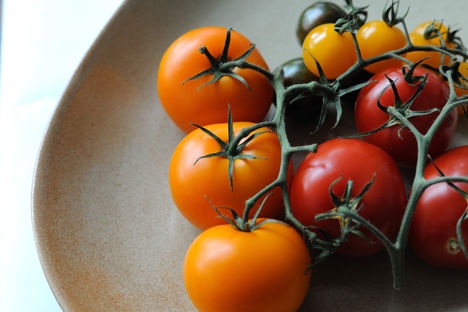The origins of the humble tomato can be traced back thousands of years to Mexico, but they were not actually introduced to the UK until the late 16th century from Europe. At this time they were predominantly used ornamentally in Italy, and the actual consumption of tomatoes did not really become popular until as late as the 1750s.
The tomato is part of the deadly nightshade family, and as such the leaves are poisonous. Luckily though, the fruit is edible and high in vitamin C and antioxidants, including lycopene, which is said to protect against heart disease and certain cancers, especially when consumed with olive oil which helps the body absorb the lycopene.
Widely considered as a vegetable for culinary purposes, tomatoes are actually a fruit. Easy to grow both at home and commercially, China is the largest grower in the world, producing almost 34 million tons of tomatoes a year. In Spain, the tomatina festival has been held every year since the 1950s in the small town of Bunol, where 20 000 people gather for a huge tomato-throwing street food fight - approximately 100 tons of tomatoes are thrown during the fight.
What to look for when buying tomatoes
There are many different types of tomato, ranging from the tiny cherry tomato, to the largest beefsteak. They come in a variety of colours; green, yellow orange, red and the tiger tomato is striped. Heirloom, or heritage tomatoes, are ‘open pollinated’ which means they are pollinated by natural methods (the pollination of insects and bees, but also birds). These kinds of tomatoes tend to have more flavour and character as a result of this pollination. They are slowly finding their way into supermarkets, but greengrocers and farmers markets are still the best place to find high quality tomatoes.
Although tomatoes are available in the supermarkets all year round, the British season begins at the end of June and carries right through until October. These months are best for using fresh tomatoes, and then in the winter months, perhaps steer more towards using delicious sun-dried versions which can come stored in oil or in vacuum pack bags. Equally, don’t dismiss tinned tomatoes as an inferior product, good quality brands pick the tomatoes when perfectly ripe and package them quickly to retain the most flavour. These are great for using in a multitude of dishes, such as curries, pasta and chilli.
When buying, select tomatoes that are ripe; this is indicated by soft flesh and bright skin. They should be unblemished and are best stored stem side down at room temperature. Keep tomatoes out of direct sunlight to preserve their high vitamin C content.
How to cook with tomatoes
Tomatoes are a staple food in many European cuisines, especially Italy, Greece and Spain. Needing no actual cooking, they can be simply sliced and served as part of a salad, often served with basil and mozzarella for a simple summer lunch, or in a sandwich as a delicious BLT. Tomatoes are the star ingredient in refreshing gazpacho and salsas, or for a more warming winter soup.
Tomatoes are the base for many curries, a host of pasta and gnocchi dishes, and smeared on the base of a tempting pizza. Concentrated tomato purée can be added to sauces and stews to help thicken and add flavour.
Uses
Tomatoes can be used in many kinds of mediterranean dishes, Tom Aikens’ draws on Spanish influences with his summery Cherry tomato gazpacho, Galton Blackiston whips up a simple French provençal dish of Ratatouille, while Russell Brown looks to Italy with his Potato gnocchi and fresh tomato sauce.
For a speedy supper, Paul Heathcote uses tomatoes as the base for his Quick vegetable curry, and Marcello Tully makes them part of his simple Tomato mac ‘n’ cheese. The more adventurous should try Frances Atkins’ beautifully intricate Tomato and basil press.
For breakfast, Shaun Rankin makes a tempting sun-dried tomato bread, and who could forget the ultimate hangover cure, the Bloody Mary?
Get in touch
Please sign in or register to send a comment to Great British Chefs.



